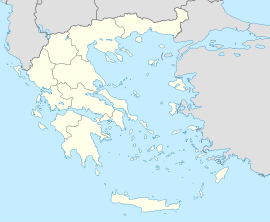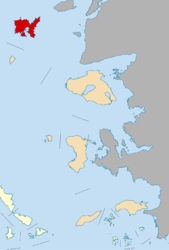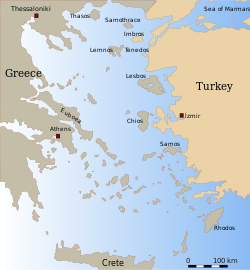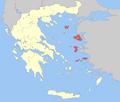لمنوس
لمنوس
Λήμνος Limnos | |
|---|---|
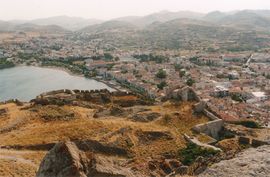 | |
| الإحداثيات: 39°55′N 25°15′E / 39.917°N 25.250°ECoordinates: 39°55′N 25°15′E / 39.917°N 25.250°E | |
| البلد | |
| المنطقة الادارية | شمال إيجة |
| الوحدة المحلية | لمنوس |
| المساحة | |
| • البلدية | 476 كم² (184 ميل²) |
| أعلى منسوب | 470 m (1٬540 ft) |
| أوطى منسوب | 0 m (0 ft) |
| التعداد (2011)[1] | |
| • البلدية | 16٬992 |
| • كثافة البلدية | 36/km2 (92/sq mi) |
| منطقة التوقيت | UTC+2 (EET) |
| • الصيف (التوقيت الصيفي) | UTC+3 (EEST) |
| Postal code | 81400 |
| مفتاح الهاتف | 22540 |
| Vehicle registration | MH, MY |
| الموقع الإلكتروني | www.limnos.gr |
لمنوس (باليونانية: [Λήμνος, Limnos] Error: {{Lang}}: text has italic markup (help)؛ إنگليزية: Lemnos) هي جزيرة يونانية في الجزء الشمالي من بحر إيجة. وادارياً تشكل الجزيرة بلدية منفصلة ضمن الوحدة الادارية لمنوس، التي هي جزء من منطقة شمال إيجة. البلدة الرئيسية للجزيرة ومقر البلدية هي ميرينا.[2] وبمساحة 477 كم²، تُعد لمنوس ثامن أكبر جزيرة في اليونان.
. . . . . . . . . . . . . . . . . . . . . . . . . . . . . . . . . . . . . . . . . . . . . . . . . . . . . . . . . . . . . . . . . . . . . . . . . . . . . . . . . . . . . . . . . . . . . . . . . . . . . . . . . . . . . . . . . . . . . . . . . . . . . . . . . . . . . . . . . . . . . . . . . . . . . . . . . . . . . . . . . . . . . . . .
الجغرافيا
المناخ
| بيانات مناخ جزيرة لمنوس | |||||||||||||
|---|---|---|---|---|---|---|---|---|---|---|---|---|---|
| الشهر | يناير | فبراير | مارس | أبريل | مايو | يونيو | يوليو | أغسطس | سبتمبر | اكتوبر | نوفمبر | ديسمبر | العام |
| العظمى القياسية °س (°ف) | 18.8 (65.8) |
19.0 (66.2) |
22.0 (71.6) |
25.8 (78.4) |
29.8 (85.6) |
34.4 (93.9) |
39.4 (102.9) |
35.8 (96.4) |
32.8 (91) |
31.2 (88.2) |
24.0 (75.2) |
19.2 (66.6) |
39٫4 (102٫9) |
| العظمى المتوسطة °س (°ف) | 10.7 (51.3) |
10.9 (51.6) |
12.9 (55.2) |
17.3 (63.1) |
21.9 (71.4) |
26.8 (80.2) |
29.0 (84.2) |
28.2 (82.8) |
25.2 (77.4) |
20.1 (68.2) |
15.3 (59.5) |
12.5 (54.5) |
19٫2 (66٫6) |
| المتوسط اليومي °س (°ف) | 7.5 (45.5) |
7.9 (46.2) |
9.9 (49.8) |
13.8 (56.8) |
18.4 (65.1) |
23.3 (73.9) |
25.5 (77.9) |
24.6 (76.3) |
21.4 (70.5) |
16.6 (61.9) |
12.3 (54.1) |
9.3 (48.7) |
15٫9 (60٫6) |
| الصغرى المتوسطة °س (°ف) | 4.2 (39.6) |
4.7 (40.5) |
6.2 (43.2) |
8.8 (47.8) |
12.8 (55) |
16.8 (62.2) |
19.7 (67.5) |
19.8 (67.6) |
16.4 (61.5) |
12.4 (54.3) |
9.1 (48.4) |
6.1 (43) |
11٫4 (52٫5) |
| الصغرى القياسية °س (°ف) | -5.0 (23) |
-4.2 (24.4) |
-6.0 (21.2) |
1.0 (33.8) |
3.4 (38.1) |
3.4 (38.1) |
12.0 (53.6) |
12.8 (55) |
8.8 (47.8) |
1.6 (34.9) |
-1.0 (30.2) |
-3.6 (25.5) |
−6٫0 (21٫2) |
| هطول mm (inches) | 72.3 (2.846) |
44.1 (1.736) |
51.6 (2.031) |
32.3 (1.272) |
23.3 (0.917) |
21.9 (0.862) |
10.3 (0.406) |
7.5 (0.295) |
19.6 (0.772) |
35.9 (1.413) |
75.4 (2.969) |
80.2 (3.157) |
474٫4 (18٫677) |
| % Humidity | 77.0 | 75.4 | 75.9 | 73.4 | 68.8 | 61.0 | 57.6 | 62.5 | 66.8 | 72.8 | 77.9 | 78.6 | 70٫6 |
| Avg. precipitation days (≥ 1.0 mm) | 7.5 | 6.2 | 5.2 | 4.2 | 3.4 | 2.6 | 1.2 | 1.2 | 1.6 | 3.8 | 7.0 | 8.4 | 52٫3 |
| Source: NOAA[3] | |||||||||||||
التاريخ


قبل التاريخ
The ruins of the oldest human settlement in the Aegean Islands found so far have been unearthed in archaeological excavations on Lemnos by a team of Greek, Italian and American archaeologists at the Ouriakos site on the Louri coast of Fyssini in Moudros municipality. The excavation began in early June 2009 and the finds brought to light, consisting mainly of high quality stone tools, are from the Epipaleolithic Period, indicating a settlement of hunters and gatherers and fishermen of the 12th millennium BC.
A rectangular building with a double row of stepped seats on the long sides, at the southwest side of the hill of Poliochne, dates back to the Early Bronze Age and was possibly used as a kind of Bouleuterion.[بحاجة لمصدر]
القِدم
Homer speaks as if there were one town in the island called Lemnos. In Classical times there were two towns, Myrina (also called Kastro) and Hephaistia,[4] which was the chief town. Coins from Hephaestia are found in considerable number, and various types including the goddess Athena with her owl, native religious symbols, the caps of the Dioscuri, Apollo, etc. Few coins of Myrina are known. They belong to the period of Attic occupation, and bear Athenian types. A few coins are also known which bear the name of the whole island, rather than of either city.
A trace of the Lemnian language is found on a 6th-century inscription on a funerary stele, the Lemnos stele. Lemnos later adopted the Attic dialect of Athens.
. . . . . . . . . . . . . . . . . . . . . . . . . . . . . . . . . . . . . . . . . . . . . . . . . . . . . . . . . . . . . . . . . . . . . . . . . . . . . . . . . . . . . . . . . . . . . . . . . . . . . . . . . . . . . . . . . . . . . . . . . . . . . . . . . . . . . . . . . . . . . . . . . . . . . . . . . . . . . . . . . . . . . . . .
العصور الوسطى
As a province of the Byzantine Empire, Lemnos belonged to the theme of the Aegean Sea, and was a target of Saracen raids in the 10th century and of Seljuk raids in the 11th century.[5][6] Following the dissolution and division of the Empire after the Fourth Crusade, Lemnos (known by Westerners as Stalimene) was apportioned to the Latin Empire, and given as a fief to the Navigajoso family under the Venetian (or possibly of mixed Greek and Venetian descent) megadux Filocalo Navigajoso.[6][7] Filocalo died in 1214, and was succeeded by his son Leonardo and his daughters, who partitioned the island into three fiefs between them. Leonardo retained the title of megadux of the Latin Empire and half the island with the capital, Kastro, while his sisters and their husbands received one quarter each with the fortresses of Moudros and Kotsinos. Leonardo died in 1260 and was succeeded by his son Paolo Navigajoso, who resisted Byzantine attempts at reconquest until his death during a siege of the island by the Byzantine admiral Licario in 1277. Resistance continued by his wife, but in 1278 the Navigajosi were forced to capitulate and cede the island back to Byzantium.
الفترة العثمانية
Following the fall of Constantinople (1453), and thanks to the intercession of Michael Critobulus, Sultan Mehmed II recognized Dorino I Gattilusio's possession of Lemnos and Thasos in exchange for an annual tribute of 2,325 gold coins. When Dorino died in 1455, his son and successor Domenico was only granted Lemnos, however.[6] In 1456, Mehmed II attacked and captured the Gattilusi domains in Thrace (Ainos and the islands of Samothrace and Imbros). During the subsequent negotiations with Domenico Gattilusio, the Greek populace of Lemnos rose up against Domenico's younger brother Niccolò Gattilusio and submitted to the Sultan, who appointed a certain Hamza Bey as governor under the Bey of Gallipoli, Isma'il.[8] Mehmed granted a special legal charter (kanun-name) to Lemnos, Imbros, and Thasos, at this time, later revised by Selim I in 1519.[6] In 1457 a Papal fleet under Cardinal Ludovico Scarampi Mezzarota captured the island.[6] Pope Callixtus III (in office 1455-1458) hoped to establish a new military order on the island, which controlled the exit of the Dardanelles, but nothing came of it as Isma'il Bey soon recovered Lemnos for the Sultan.[8]
العصر الحديث

البلدية
The present municipality of Lemnos was formed on the merger of the following four former municipalities, each of which became municipal units, following the 2011 local government reform:[2]
Lemnos and the smaller island of Agios Efstratios previously formed part of Lesbos Prefecture. In 2011, the prefecture was abolished and Lemnos and Agios Efstratios now form Lemnos Regional Unit. Lemnos Province, abolished in 2006, comprised the same territory as the present regional unit.
التقسيمات
الوحدات البلدية Atsiki, Moudros, Myrina and Nea Koutali are subdivided into the following communities (القرى المنضوية توجد بين أقواس):
أتسيكي
مودروس
- فيسيني (Fisini, Agia Sofia)
- كاليوپي
- كامينيا (كامينيا، ڤوروسكوپوس)
- كونتوپولي (Kontopouli, Agios Alexandros, Agios Theodoros)
- ليخنا (Lychna, Anemoessa)
- مودروس (مودروس، كوكونيسي)
- پاناگيا (پاناگيا، كورتيسوناس)
- پلاكا
- Repanidi (Repanidi, Kotsinos)
- Roussopouli
- رومانو
- Skandali
ميرينا
- ميرينا (ميرينا، بما في ذلك أندروني)
- ثانوس (Thanos, Paralia Thanous)
- Kaspakas (Kaspakas, Agios Ioannis, Gali, Limenaria)
- كورنوس (Kornos, Psylloi)
- Platy (Platy, Paralia Plateos, Plagisos Molos)
نيا كوتالي
- Angariones
- Kallithea
- Kontias
- Livadochori (Livadochori, Poliochni)
- نيا كوتالي
- پدينو (Neo Pedino, Palaio Pedino, Vounaria)
- Portianou
- Tsimandria
أشهر أبنائها
- ألكامنس (القرن الخامس ق.م.)، مثـّال
. . . . . . . . . . . . . . . . . . . . . . . . . . . . . . . . . . . . . . . . . . . . . . . . . . . . . . . . . . . . . . . . . . . . . . . . . . . . . . . . . . . . . . . . . . . . . . . . . . . . . . . . . . . . . . . . . . . . . . . . . . . . . . . . . . . . . . . . . . . . . . . . . . . . . . . . . . . . . . . . . . . . . . . .
انظر أيضاً
- Lemnian language
- Lemniscate
- هدنة مودروس (أو موندروس)
الهامش
- ^ أ ب "Απογραφή Πληθυσμού - Κατοικιών 2011. ΜΟΝΙΜΟΣ Πληθυσμός" (in اليونانية). Hellenic Statistical Authority.
- ^ أ ب Kallikratis law Greece Ministry of Interior (باليونانية)
- ^ "Limnos Island Climate Normals 1961-1990". National Oceanic and Atmospheric Administration. Retrieved January 29, 2013.
- ^ "Hephaistia". Pleiades, directory of Ancient Places. May 2019.
- ^ قالب:ODB
- ^ أ ب ت ث ج de Groot, A. H. (1986). "Limni". In Bosworth, C. E.; van Donzel, E.; Lewis, B.; Pellat, Ch. (eds.). The Encyclopaedia of Islam, New Edition, Volume V: Khe–Mahi. Leiden: E. J. Brill. pp. 763–764. ISBN 90-04-07819-3.
{{cite encyclopedia}}: Invalid|ref=harv(help) - ^ قالب:The Latin Renovatio of Byzantium
- ^ أ ب Kramers, J. H. (1987). "Limni". In Houtsma, Martijn Theodoor (ed.). E.J. Brill's first encyclopaedia of Islam, 1913–1936, Volume V: L–Moriscos. Leiden: BRILL. pp. 27–28. ISBN 90-04-08265-4.
المصادر
- This article incorporates text from a publication now in the public domain: Chisholm, Hugh, ed. (1911). دائرة المعارف البريطانية (eleventh ed.). Cambridge University Press.
{{cite encyclopedia}}: Cite has empty unknown parameter:|coauthors=(help); Missing or empty|title=(help)
وصلات خارجية
- CS1 اليونانية-language sources (el)
- Short description is different from Wikidata
- Coordinates on Wikidata
- Lang and lang-xx template errors
- Articles containing إنگليزية-language text
- Articles with unsourced statements from March 2008
- Articles with hatnote templates targeting a nonexistent page
- CS1 errors: missing title
- مقالات المعرفة المحتوية على معلومات من دائرة المعارف البريطانية طبعة 1911
- Wikipedia articles incorporating text from the 1911 Encyclopædia Britannica
- أماكن مأهولة في لمنوس
- جزر اليونان
- لمنوس
- مواقع في الإلياذة
- بلديات شمال إيجة
- السياحة في اليونان
- تضاريس لمنوس (وحدة محلية)
- جزر شمال إيجة

